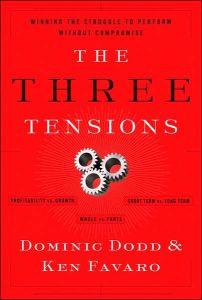Join getAbstract to access the summary!

Join getAbstract to access the summary!
Dominic Dodd and Ken Favaro
The Three Tensions
Winning the Struggle to Perform Without Compromise
Jossey-Bass, 2007
What's inside?
Quit trying to balance growth versus profits, short- versus long-term gains, the company versus its parts. Instead, cure the tensions.
Recommendation
Dominic Dodd and Ken Favaro explain how companies try to solve the conflicts between competing business goals by making unnecessary compromises, and then get trapped in the never-ending spin of “the corporate cycle.” Their book shows how to resolve three central “tensions”: whether to grow or profit, whether to take a short view or a long view, and whether to favor individual units or the larger firm. Their case histories detail how leading companies (Cadbury Schweppes, Gillette and Nokia) thrived by resolving their tensions – and how other major corporations (General Motors and Coca-Cola) lost ground by not heeding them. Dodd and Favaro’s “customer benefit” mantra is simple but appealing, and their writing is pretty sharp. The authors make their case using Russian proverbs, metaphors such as “the mud hut conundrum” and amusing anecdotes of managers caught on the tension treadmill. Their “new way of thinking” sometimes evokes a motivational speaker at the local Holiday Inn, but the authors readily concede that carrying out their advice isn’t easy. They quote some blunt wisdom from corporate executives to add a needed dose of real world gravitas. getAbstract recommends this useful analysis to managers who are trying to balance equally worthy priorities.
Summary
About the Authors
Dominic Dodd is managing director of an international consultancy and Ken Favaro is its co-chairman.
















Comment on this summary